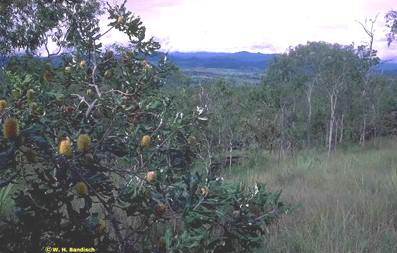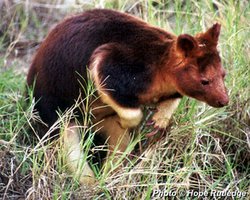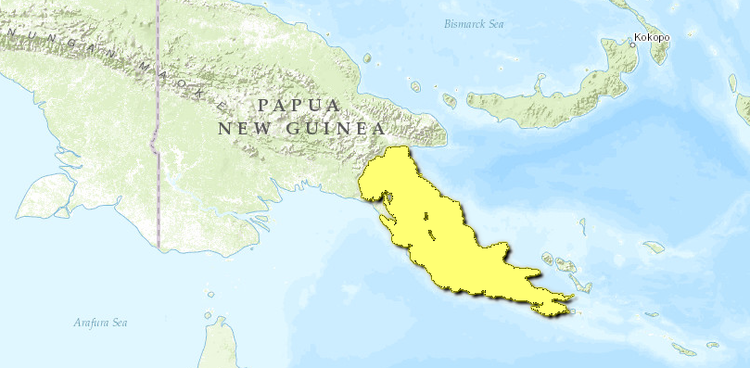Southeastern Papuan rain forests

Varirata National Park, southeast Papua New Guinea. (Photograph by W.H. Bandisch, courtesy of Papua New Guinea Orchid News)
Introduction The Southeastern Papuan rain forests—dominated by the Owen Stanley highlands, the major mountain range in the ecoregion (Southeastern Papuan rain forests) —contain vast tracts of pristine montane forests. Because of the dissected landscape and edaphic variations, the ecoregion is rich in endemic species with very local distributions. Although some of Papua New Guinea's (PNG's) major population centers, including the capital, Port Moresby, are located in this ecoregion, major wilderness areas are still present. This ecoregion is extremely rich because of the diversity of its habitats: it includes coastal, lowland, and montane habitats.
Location and General Description
This lowland and montane ecoregion is made up of the Owen Stanley Range and surrounding lowland and coastal areas in southeastern PNG. The climate of the ecoregion is tropical wet, which is characteristic of this part of Melanesia, located in the western Pacific Ocean north of Australia. The surface geology of the Central Cordillera, of which the Owen Stanleys are an extension, is generally composed of metamorphic and intrusive igneous rocks. More specifically, this ecoregion is composed of metamorphosed Mesozoic greywacke sandstone, siltstone, and marine volcanics overlain by Miocene intrusives, Pliocene marine and terrestrial fine-grained sediments, and Quaternary lavas and pyroclastics.
Most of this ecoregion is composed of tropical wet evergreen forest, with a significant (25 percent) percentage of tropical montane evergreen forest. Smaller percentages of upper montane and freshwater swamp forest are also found. Coastal vegetation contains Casuarina, whereas mixed coastal vegetation contains Calophyllum, Terminalia, and Anisoptera.
 Goodfellow's tree kangaroo (Dendrolagus matschiei (goodfellowi)). (Photograph by Hope Rutledge)
Goodfellow's tree kangaroo (Dendrolagus matschiei (goodfellowi)). (Photograph by Hope Rutledge)
Lowland forest up to 1,400 meters (m) on the north side of the Owen Stanleys is made up of Pometia, Terminalia, Myristica, Horsfieldia, Celtis, and Ficus. Lowland forest is made up of both alluvial and hill types. Lowland alluvial forest has a canopy that is multitiered and irregular, with many emergents. The forest understory contains a shrub-and-herb layer with a variety of climbers, epiphytes, and ferns. Palms may be common in the shrub layer. The somewhat lower-canopy, more closed lowland hill forest contains more open shrub layer but a denser herbaceous layer. Palms are fewer in number. The dominant canopy trees include species of Pometia, Canarium, Anisoptera, Cryptocarya, Terminalia, Syzygium, Ficus, Celtis, Dysoxylum, and Buchanania. Koompassia, Dillenia, Eucalyptopsis, Vatica, and Hopea are locally abundant. Dense stands of Araucaria, the tallest tropical trees in the world, are present in scattered locations.
Although they are subject to variable climates and topography, montane forests are smaller crowned and have more even canopies than lowland hill forest. Tree densities can be high, and the shrub density is also high. Lower montane forest transitioning in from the lowlands is dominated by oaks such as Castanopsis acuminatissima, Lithocarpus, elaeocarps, and laurels. Seventy-meter Araucaria may form thick stands in lower areas. Nothofagus, sometimes in monotypic stands, is conspicuous in the moss-covered mid- and upper zones of the ecoregion.
Biodiversity Features
Overall richness is generally high and endemism is generally moderate to high when compared with those of other ecoregions in Indo-Malaysia. Bird richness and reptile and amphibian richness and endemism are particularly high in this ecoregion.
|
Table 1. Endemic and Near-Endemic Mammal Species. Family Species Dasyuridae Murexia rothschildi* Dasyuridae Planigale novaeguineae Peroryctidae Peroryctes broadbenti* Peroryctidae Microperoryctes papuensi* Macropodidae Dorcopsulus macleayi Macropodidae Dorcopsis luctuosa Macropodidae Thylogale brunii Pteropodidae Syconycteris hobbit Vespertilionidae Pipistrellus collinus Vespertilionidae Pharotis imogene* Vespertilionidae Kerivoula muscina Molossidae Otomops papuensis Molossidae Otomops secundus Rhinolophidae Hipposideros muscinus Muridae Leptomys elegans Muridae Neohydromys fuscus Muridae Pseudohydromys murinus Muridae Mayermys ellermani Muridae Crossomys moncktoni Muridae Chiruromys forbesi Muridae Chiruromys lamia* Muridae Xenuromys barbatus Muridae Melomys levipes* Muridae Rattus novaeguineae Muridae Hydromys shawmayeri Muridae Leptomys ernstmayeri Muridae Melomys gracilis Muridae Stenomys vandeuseni* An asterisk signifies that the species' range is limited to this ecoregion. The mammalian fauna consists of a wide variety of tropical Australasian marsupials, including tree kangaroos. There are 138 mammal species in the ecoregion, of which 28 are endemic or near endemic (Table 1). Included are the critically endangered large-eared nyctophilus (Pharotis imogene) and long-footed hydromine (Leptomys elegans) and Van Deusen's rat (Stenomys vandeuseni). The avifauna of the ecoregion (Southeastern Papuan rain forests) has a clear Australasian flavor, including representatives of several Australasian families such as Ptilonorhynchidae, Eopsaltriidae, Meliphagidae, and Paradisaeidae. Because the ecoregion includes coastal, lowland, and montane areas, the number of birds found in the ecoregion is quite large (510 bird species). Forty of these are endemic or near endemic (Table 2). This ecoregion constitutes the eastern end of the Central Papuan mountains Endemic Bird Area (EBA). Whereas the EBA contains a total of fifty-three restricted-range birds, this ecoregion contains only some of them, twenty-seven of which are shared with the Central Range montane rain forests ecoregion, one of which is also found in the Central Range sub-alpine grasslands, and two of which are found nowhere else on Earth: the streaked bowerbird (Amblyornis subalaris) and eastern parotia (Parotia helenae). {| border="1" cellpadding="3" align="center" ! colspan="3" align="center" | Table 2. Endemic and Near-Endemic Bird Species. Family Common Name Species Psittacidae Painted tiger-parrot Psittacella picta Psittacidae Madarasz's tiger-parrot Psittacella madaraszi Caprimulgidae Mountain eared-nightjar Eurostopodus archboldi Apodidae Bare-legged swiftlet Aerodramus nuditarsus Alcedinidae Brown-headed paradise-kingfisher Tanysiptera danae* Motacillidae Alpine pipit Anthus gutturalis Acanthizidae Papuan thornbill Acanthiza murina Pachycephalidae Wattled ploughbill Eulacestoma nigropectus Eopsaltriidae Greater ground-robin Amalocichla sclateriana Eopsaltriidae Alpine robin Petroica bivittata Pachycephalidae White-bellied whistler Pachycephala leucogastra Pachycephalidae Black sittella Daphoenositta miranda Climacteridae Papuan treecreeper Cormobates placens Cinclosomatidae Brown-capped jewel-babbler Ptilorrhoa geislerorum Cinclosomatidae Blue-capped ifrita Ifrita kowaldi Melanocharitidae Obscure berrypecker Melanocharis arfakiana Estrildidae Alpine munia Lonchura monticola* Estrildidae Grey-headed munia Lonchura caniceps* Estrildidae Mountain firetail Oreostruthus fuliginosus Meliphagidae Silver-eared honeyeater Lichmera alboauricularis Meliphagidae Leaden honeyeater Ptiloprora plumbea Meliphagidae Spot-breasted meliphaga Meliphaga mimikae Meliphagidae Rufous-backed honeyeater Ptiloprora guisei Meliphagidae Black-backed honeyeater Ptiloprora perstriata Meliphagidae Olive-streaked honeyeater Ptiloprora meekiana Meliphagidae Yellow-browed honeyeater Melidectes rufocrissalis Meliphagidae Cinnamon-browed honeyeater Melidectes ochromelas Meliphagidae Sooty honeyeater Melidectes fuscus Meliphagidae Belford's honeyeater Melidectes belfordi Ptilonorhynchidae Streaked bowerbird Amblyornis subalaris* Paradisaeidae Crested bird-of-paradise Cnemophilus macgregorii Paradisaeidae MacGregor's bird-of-paradise Macgregoria pulchra Paradisaeidae Brown sicklebill Epimachus meyeri Paradisaeidae Princess Stephanie's astrapia Astrapia stephaniae Paradisaeidae Yellow-breasted bird-of-paradise Loboparadisea sericea Paradisaeidae Loria's bird-of-paradise Cnemophilus loriae Paradisaeidae Eastern parotia Parotia helenae* Paradisaeidae Lawes's parotia Parotia lawesii Paradisaeidae Blue bird-of-paradise Paradisaea rudolphi Paradisaeidae Greater melampitta Melampitta gigantea An asterisk signifies that the species' range is limited to this ecoregion. Within this ecoregion, the Kodama Range, with eight endemic species; the Western Owen Stanley Range, with seven endemic species; the Central Owen Stanley Range, with five endemic species; and the Southeastern Coastal area, with one endemic species, are all centers of butterfly endemicity on the island of New Guinea. There are seven recognized Centres of Plant Diversity (CPD) located in this ecoregion (Southeastern Papuan rain forests) , some of which are shared with the higher Central Range sub-alpine grasslands ecoregion. The Galley Reach CPD contains mangrove, lowland swamp, and Nypa communities. Galley Reach contains most of the mangrove species in Papuasia, which in turn has the most mangrove diversity. The Menyamya-Aseki-Amungwiwa-Bowutu Mountains-Lasanga Island CPD ranges from sea level to 3,278 meters (m) and represents the diversity of the altitudinal gradient on the north side of the Owen Stanley Range. Lowland rain forests (with extensive dipterocarp forest), lowland swamp forests, lower to upper montane forests, and sub-alpine forests are all represented here. Ultramafic vegetation is found in the Bowutu Mountains. Important lowland forest and ultramafic substrate endemics are found in the Milne Bay-Collinwood Bay to southern coast CPD. The Owen Stanley Mountains CPD contains many local endemics and is the center of diversity for Agapetes (Ericacae). The Varirata and Astrolabe ranges, Safia Savanna, and Topographer's Range CPDs are all little-known areas that merit further study. The lowland forests are home to the world's largest butterfly, Ornithoptera alexandrae, a globally threatened species. ==Current Status== The East Peninsula Highlands and the North Peninsula Highlands constitute major wilderness areas. Five protected areas make up only about 6 percent of the ecoregion area (Table 3). Two of the protected areas, Mts. Albert Edward/Victoria and Morobe, are large, more than 1,000 km2 in size. {| border="1" cellpadding="3" align="center" ! colspan="3" align="center" | Table 3. WCMC (1997) Protected Areas That Overlap with the Ecoregion. Protected Area Area (km2) IUCN Category Morobe 1,430 ? Popondetta 750 ? Mt. Suckling 600 ? Abau 550 ? Mts. Albert Edward/Victoria 1,600 ? Total 4,930 Ecoregion numbers of protected areas that overlap with additional ecoregions are listed in brackets. (Southeastern Papuan rain forests) ==Types and Severity of Threats== Although the threats to this ecoregion are low, potential threats include logging, nickel exploitation, and traditional agriculture. The extension of the highway from the capital, Port Moresby, through to Milne Bay will increase accessibility of the coastal plain south of the Owen Stanley Ranges, opening this extensive forest area to exploitation. ==Justification of Ecoregion Delineation== Using Whitmore's map of the vegetation of Malesia and MacKinnon's reconstruction of the original vegetation, we delineated the large areas of distinct habitat types as [[ecoregion]s]. The montane evergreen moist forests along the Central Cordillera, including the Snow Mountains, Star Mountains, Central Highlands, and Eastern Highlands, were placed in the Central Range montane rain forests. This ecoregion roughly corresponds to MacKinnon's subunits P3g, P3h, and P3i. The moist forests in the southeastern peninsula were distinguished as the Southeastern Papuan rain forests. This ecoregion consists mostly of montane forests but also includes some lowland forests along the [[coast]s] and is roughly equivalent to MacKinnon's biounit P3n. We used the 1,000-meter (m) contour from a digital elevation model (DEM) to define the montane-lowland transition. All along the Central Cordillera and in the Huon Peninsula, we separated the alpine habitat into a distinct-Central Range sub-alpine grasslands-ecoregion. Udvardy placed these ecoregions in the Papuan biogeographic province of the Oceanian Realm. ==Additional information on this ecoregion== * For a shorter summary of this entry, see the WWF WildWorld profile of this ecoregion. * To see the species that live in this ecoregion, including images and threat levels, see the WWF Wildfinder description of this ecoregion. * World Wildlife Fund Homepage |
|---|
